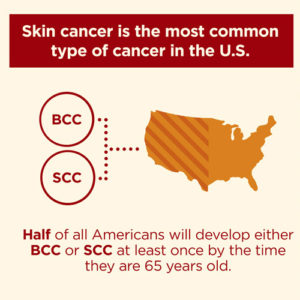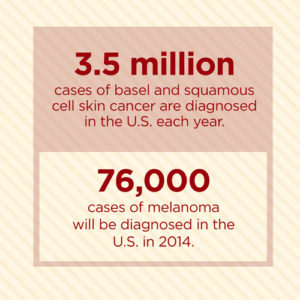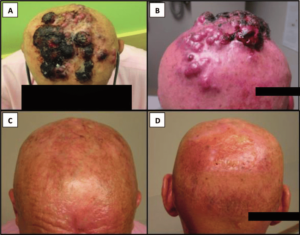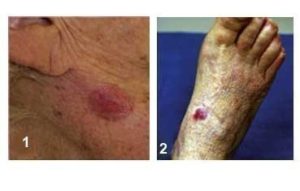Continuation of Types of Skin Cancer:
3-Squamous cell carcinoma – SCC
Squamous cell carcinoma is the second most common form of skin cancer in the United States. It accounts for about 15 percent of all skin cancers. It is caused due to over production of skin cells. Squamous cell carcinoma of the skin is caused by DNA damage that leads to abnormal changes (mutations) in the squamous cells in the outermost layer of skin. This cancer is common (More than 200,000 cases per year in US). The majority of squamous cell skin cancers are easily and successfully treated with current therapies.
Knowing the causes, risk factors and warning signs can help you detect them early, when they are easiest to treat and cure.
The risk factors of Squamous Cell Carcinoma are:
–UV exposure from the sun or indoor tanning.
-History of skin cancer, including squamous cell carcinoma (SCC) or melanoma
– Age over 50: Most BCCs appear in people over age 50.
-Fair skin: People with fair skin have an increased risk.
Warning Signs can help with early detection and treatment this can be successfully removed without complications. Look out for any new, changing or unusual skin growths, so you can spot skin cancers like BCC when they are easiest to treat and cure.
IT’S A FACT, Squamous cell carcinoma is considered more aggressive than basal cell carcinoma. If squamous cell carcinoma does spread to internal organs it can be life threatening. The quicker the treatment when SCC is in the one layer of skin only the better the results. The primary symptom to look out for with SCC is a growing bump or lesion on the skin which has a rough scaly surface or flat red patches.
4-Merkel Cell Carcinoma
This is a type of skin cancer characterized by flesh-colored nodule that occurs on the face, head or neck. It begins in the cells at the base of the uppermost layer of the skin (epidermis). A normal Merkel cell is a cross between a nerve cell and an endocrine (or hormone-producing) cell located on or just below the skin in the underlying tissue, and functions predominantly as a touch receptor. Merkel cell carcinoma occurs when these cells begin to grow uncontrollably.
Merkel cell tumors typically arise on, but are not limited to, sun-exposed parts of the body such as the face and neck. Their shape and color are less distinctive than other skin cancers, and they can often appear as an innocent pink pearly nodule. As a result, it is usually only the speed with which they grow that attracts the attention of patients and their doctors.
With early detection and treatment, Merkel cell carcinoma can be well contained and even cured. Treatment becomes more difficult as the tumor grows and spreads, but aggressive therapy can still lead to high rates of survival.
Again, Warning Signs can help with early detection and treatment this can be successfully removed without complications. Look out for any new, changing or unusual skin growths, so you can spot skin cancers like BCC when they are easiest to treat and cure.
Risk Factors of Merkel Cell Carcinoma:
–UV exposure from the sun or indoor tanning.
-History of skin cancer, including squamous cell carcinoma (SCC) or melanoma
– Age over 50: Most BCCs appear in people over age 50.
-Fair skin: People with fair skin have an increased risk.
-Male gender: Men are more likely to develop BCC.
-Merkel Cell Virus. Recently, researchers have linked a virus to many cases of Merkel cell carcinoma. However, it remains to be determined if the Merkel cell polyomarvirus causes the disease, and if it might help guide future treatment. If so, the virus could offer promising new targets for immunotherapy.
IT’S A FACT, Memorial Sloan Kettering Hospital in NYC states “Merkel cell carcinoma, also called neuroendocrine cancer of the skin, is an aggressive type of skin cancer that affects only about 400 people in the United States each year. But like other skin cancers, that number is growing.”.








